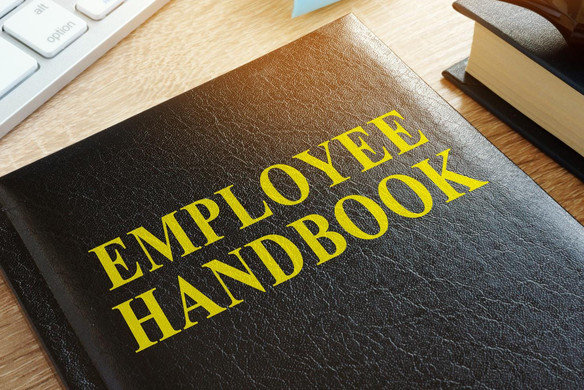Table of contents
This article was contributed by our friends at Forbes.
Square cannot provide advice on tax issues. This article is for educational purposes and does not constitute legal or tax advice. For specific advice applicable to your business, please contact a professional.
An employee handbook is one of the most important components employment attorneys advise companies to have and update regularly. The reasons for this are simple: employee handbooks not only formalize guidelines, expectations, and terms and conditions of employment, but, more importantly, they can also help provide a layer of protection against employee claims and lawsuits.
A thorough and detailed employee handbook, reviewed and signed by the employee, establishes that both company and employee are aware of the employee and company’s legal rights and obligations. In addition, should the business ever face an employee claim or lawsuit, the handbook also serves as a helpful legal defense by demonstrating that the company strives to operate in compliance with all relevant federal, state, and local laws.
Writing your employee handbook
Understandably, developing an employee handbook from scratch can feel like an overwhelming task. An experienced employment attorney can help you create a comprehensive handbook that addresses the most fundamental policies. If you decide to strike out on your own, however, the following is a list of essential topics to address:
- Compensation and benefit policies
- Vacation, sick, and paid or unpaid leave policies
- Dress code
- Workplace safety and security policies
- Non-disclosure agreements and conflict of interest statements
- Internet usage policies
- How to file or report workplace complaints
- Equal employment, disability, and anti-discrimination policies
- Workers’ compensation policies
Once your handbook is in place, this is not a case of “set it and forget it.” Instead, you’ll want to review it annually, ideally in partnership with your employment attorney, and make the necessary employee handbook updates. These could include changes to corporate policies or local, state, or federal laws and regulations.
Some timely employee handbook updates that I’m advising my clients to address in 2022 include:
Vacation policies
Some states have recently implemented rulings stating that if an employer provides paid vacation, any accrued and unpaid vacation time is considered earned wages and must be paid out at the end of the employment relationship. It’s important to note that these rulings would apply to employers regardless of where their business is headquartered. In an era of remote work, that is an important distinction.
Do now: Check with an employment attorney to ensure that your policy is compliant with your state’s laws.
Covid-19 and sick leave policies
The Covid-19 pandemic has created an ever-changing patchwork of federal and state policies and acts related to paid sick-leave provisions and tied to federal and state government declarations of public health emergencies.
For example, in some states, employers must supplement paid sick leave until four weeks after the official termination or suspension of the federally declared public health emergency.
Do now: Check with an employment attorney to determine the specific Covid-19 sick-leave requirements that apply to your business and make the appropriate employee handbook updates.
Respecting LGBTQ rights
Workplace standards related to gender identity and sexual orientation have changed markedly in recent years, emphasized by a recent landmark U.S. Supreme Court decision that declared it illegal for employers to discriminate against LGBTQ employees.
Do now: Make sure your employee handbook clearly identifies and strictly prohibits workplace missteps that are not only offensive to LGBTQ employees, but could also open the company up to discrimination, harassment, or hostile work environment claims. Include gender identity, gender expression, and sexual orientation among the list of protected categories in your employee handbook.
Review all policies (dress code, vacation, email signatures, gender-segregated spaces, etc.) to confirm they are inclusive of LGBTQ individuals. The Human Rights Campaign Foundation provides an extremely helpful and comprehensive employer toolkit to assist employers in this effort.
Paid family leave
Although the United States has not implemented a federal paid leave act, some states are striking out on their own. For example, beginning January 1, 2024, Colorado’s Paid Family and Medical Leave Insurance (FAMLI) Act will require employers to provide 12 weeks of leave, with an option for four more weeks for birth mothers with complications.
Notably, the leave isn’t limited to parents of new babies — employees can use the benefits for other reasons, such as recovering from or receiving treatment for an illness, caring for a family member, or other approved circumstances.
Do now: Get ahead of the paid family leave trend now and consider mirroring a policy similar to Colorado’s sooner rather than later. It’s worth noting that employers should ensure their policy is equitable for male employees in same-sex partnerships by offering paternity leave in addition to maternity leave. Paid family leave policies should also treat adoptive and biological parents the same.
Remote work, workplace safety, and vaccine/mask policies
The preponderance of employees who now work remotely for all or part of the workweek, combined with vaccine and mask requirements for in-person work, demonstrates just how much Covid-19 has changed the workplace.
Do now: Clearly outline remote work policies in the employee handbook, including any parameters around eligibility, office hours and expectations, and company-provided equipment usage. Include vaccination, mask, and Covid-19 testing and quarantine policies in the handbook.
The Department of Labor’s Occupational Safety and Health Administration (OSHA) has issued guidance for employers on mitigating and preventing the spread of Covid-19 at work. Consult with an employment attorney if you do not clearly understand the federal, state, and local vaccine and mask mandates to avoid potential employee discrimination or litigation claims.
Dress code
Employers may be surprised to know that company dress codes and grooming policies could lead to various legal claims regarding discrimination and stereotyping. For example, a dress code that prohibits certain kinds of ethnic dress, such as traditional African or East Indian attire, but otherwise permits casual dress would treat some employees less favorably because of their national origin. In addition, some state laws explicitly protect certain hairstyles, such as braids, locs, and cornrows, that are commonly or historically associated with race.
Do now: Review your dress code to ensure that it is not discriminatory with regard to gender, race, or national origin. For example, it should not prohibit certain hairstyles commonly or historically associated with race. And employers must be willing to modify their dress codes or permit an exception if a religious accommodation is requested.
Employee handbook updates should be ongoing
Employee handbooks should be living, breathing documents that keep employees informed about the latest policies and expectations. When in doubt, seek the counsel of an experienced employment attorney to assist you in identifying blind spots and ensuring that your handbook helps limit the company’s potential legal and financial exposure.
About the author
Liz Hartsel of Fortis Law Partners provides counsel to individuals and companies of all sizes, from family-run businesses to multinational corporations.
This article was written by AllBusiness from Forbes and was legally licensed through the Industry Dive Content Marketplace. Please direct all licensing questions to [email protected].
![]()











